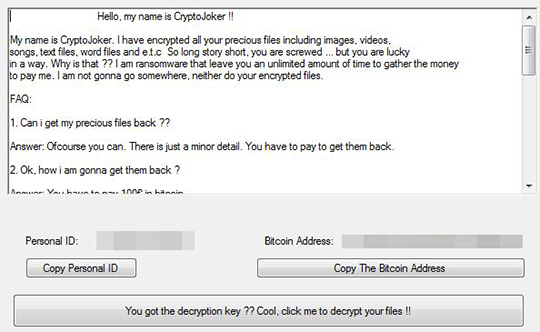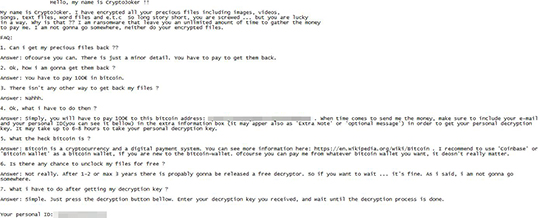RANSOM_CRYPTOJOKER.B
Trojan-Ransom.Win32.Crypmod.ykx (KASPERSKY); Ransom.Enciphered (NORTON); Ransom:MSIL/CryptJoke.B!bit [non_writable_container] (MICROSOFT)
Windows


Threat Type: Ransomware
Destructiveness: No
Encrypted: No
In the wild: Yes
OVERVIEW
Dropped by other malware, Downloaded from the Internet
This Ransomware arrives on a system as a file dropped by other malware or as a file downloaded unknowingly by users when visiting malicious sites.
It encrypts files found in specific folders. It drops files as ransom note.
TECHNICAL DETAILS
581,120 bytes
, EXE
Yes
09 Jul 2017
Drops files, Displays message/message boxes, Encrypts files
Arrival Details
This Ransomware arrives on a system as a file dropped by other malware or as a file downloaded unknowingly by users when visiting malicious sites.
Autostart Technique
This Ransomware adds the following registry entries to enable its automatic execution at every system startup:
HKEY_CURRENT_USER\Software\Microsoft\
Windows\CurrentVersion\Run
Sound Card = %Desktop%\CryptoJokerDecryptor.exe
Other Details
This Ransomware drops the following file(s)/component(s):
- %Application Data%\encKey.cryptojoker - contains encryption key
- %Application Data%\jokingwithyou.cryptojoker - necessary for decryption process
- %Desktop%\CryptoJokerDecryptor.exe - decryptor containing ransom note
(Note: %Application Data% is the Application Data folder, where it usually is C:\Documents and Settings\{user name}\Application Data on Windows 2000, Windows Server 2003, and Windows XP (32- and 64-bit); C:\Users\{user name}\AppData\Roaming on Windows Vista (32- and 64-bit), Windows 7 (32- and 64-bit), Windows 8 (32- and 64-bit), Windows 8.1 (32- and 64-bit), Windows Server 2008, and Windows Server 2012.. %Desktop% is the desktop folder, where it usually is C:\Documents and Settings\{user name}\Desktop in Windows 2000, Windows Server 2003, and Windows XP (32- and 64-bit); C:\Users\{user name}\Desktop in Windows Vista (32- and 64-bit), Windows 7 (32- and 64-bit), Windows 8 (32- and 64-bit), Windows 8.1 (32- and 64-bit), Windows Server 2008, and Windows Server 2012.)
It does the following:
- CryptoJokerDecryptor.exe displays the following:

- The malware would terminate upon finding a running process during encryption routine and would display the following at command prompt:

Ransomware Routine
This Ransomware encrypts files found in the following folders:
- %User Profile%\
(Note: %User Profile% is the current user's profile folder, which is usually C:\Documents and Settings\{user name} on Windows 2000, XP, and Server 2003, or C:\Users\{user name} on Windows Vista and 7.)
It appends the following extension to the file name of the encrypted files:
- .partially.cryptojoker
- .fully.cryptojoker
It drops the following file(s) as ransom note:
- %Desktop%\CryptoJoker Recovery Information.txt

SOLUTION
9.850
13.538.04
17 Jul 2017
13.539.00
18 Jul 2017
Step 1
Before doing any scans, Windows XP, Windows Vista, and Windows 7 users must disable System Restore to allow full scanning of their computers.
Step 2
Note that not all files, folders, and registry keys and entries are installed on your computer during this malware's/spyware's/grayware's execution. This may be due to incomplete installation or other operating system conditions. If you do not find the same files/folders/registry information, please proceed to the next step.
Step 3
Identify and terminate files detected as RANSOM_CRYPTOJOKER.B
- Windows Task Manager may not display all running processes. In this case, please use a third-party process viewer, preferably Process Explorer, to terminate the malware/grayware/spyware file. You may download the said tool here.
- If the detected file is displayed in either Windows Task Manager or Process Explorer but you cannot delete it, restart your computer in safe mode. To do this, refer to this link for the complete steps.
- If the detected file is not displayed in either Windows Task Manager or Process Explorer, continue doing the next steps.
Step 4
Restart in Safe Mode
Step 5
Delete this registry value
Important: Editing the Windows Registry incorrectly can lead to irreversible system malfunction. Please do this step only if you know how or you can ask assistance from your system administrator. Else, check this Microsoft article first before modifying your computer's registry.
- In HKEY_CURRENT_USER\Software\Microsoft\Windows\CurrentVersion\Run
- Sound Card = %Desktop%\CryptoJokerDecryptor.exe
- Sound Card = %Desktop%\CryptoJokerDecryptor.exe
Step 6
Search and delete these files
- %Application Data%\encKey.cryptojoker
- %Application Data%\jokingwithyou.cryptojoker
- %Desktop%\CryptoJokerDecryptor.exe
- %Desktop%\CryptoJoker Recovery Information.txt
Step 7
Restart in normal mode and scan your computer with your Trend Micro product for files detected as RANSOM_CRYPTOJOKER.B. If the detected files have already been cleaned, deleted, or quarantined by your Trend Micro product, no further step is required. You may opt to simply delete the quarantined files. Please check this Knowledge Base page for more information.
Step 8
Restore encrypted files from backup.
Did this description help? Tell us how we did.

